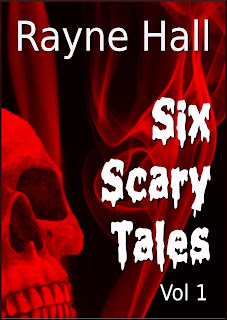December 24, 2012
- in Uncategorized by Tara Maya
Guest Post: Danger in the Dark
Rayne Hall has published more than forty books under different pen names with different publishers in different genres, mostly fantasy, horror and non-fiction. Recent books include Storm Dancer (dark epic fantasy novel), Six Historical Tales Vol 1, Six Scary Tales Vol 1, 2 and 3 (mild horror stories), Six Historical Tales (short stories), Six Quirky Tales (humorous fantasy stories), Writing Fight Scenes and Writing Scary Scenes (instructions for authors).
She holds a college degree in publishing management and a masters degree in creative writing. Currently, she edits the Ten Tales series of multi-author short story anthologies: Bites: Ten Tales of Vampires, Haunted: Ten Tales of Ghosts, Scared: Ten Tales of Horror, Cutlass: Ten Tales of Pirates, Beltane: Ten Tales of Witchcraft, Spells: Ten Tales of Magic and more.
Her short online classes for writers intense with plenty of personal feedback. Writing Fight Scenes, Writing Scary Scenes, Writing about Magic and Magicians, The Word Loss Diet and more.
For more information about Rayne Hall go to her website.
Does your story have a scene of danger or horror? Is it scary enough? Do you want your readers to fear for your main character’s safety? Here’s a simple technique on how to make a scene seriously frightening:
Turn the lights off.
Darkness makes people nervous, and everything is much more frightening in the dark. Can you change the time or location of your scene so it happens in darkness? The darker, the better. Absolute darkness is the scariest, when the protagonist sees nothing at all and has to grope their way. However, partial darkness can be spooky, too, especially with flickering lights and shadows.
Some ideas:
A windowless room
Night time
Drawn curtains
A power-cut
Fuel shortage
Energy conservation
Candles burn out
Wind blows candle
Lantern falls into abyss
Bullet shatters light-bulb
Canopy of trees blocks out the sun
New moon
Clouds veil the moon
Solar eclipse
Thick smoke
Sandstorm
Lights turned off for love-making
Deep cave
Hiding in a dark closet
Flash-light battery dies
If the storyline permits, let the darkness increase gradually:
Dusk gives way to night
The camp-fire burns down
Clouds thicken
In the dark, humans are deprived of the sense on which they rely most: seeing. Other senses sharpen, especially hearing. Your point-of-view character suddenly hears a lot more noises. These sounds add to the scary effect. In the next lesson, we’ll explore how to make the most of sounds.
If the darkness is absolute, the point-of-view character relies on her sense of touch as she gropes her way around. Describe how the walls, the furniture, the trees feel to her fingers, and how the ground feels underfoot. Smells also become more noticeable in the dark, and you can give the reader an intense experience by mentioning a smell or two.
Darkness often brings low temperatures. Chills can increase the scare factor, so mention the cool breeze brushing your heroine’s arms, the cellar’s icy stone walls, the cold water dripping from the ceiling of the cave, the chill creeping through the thin soles of her shoes.
This technique suits almost any story, whether you want to send mild shivers across the skin of the paranormal romance reader, chill the thriller reader’s bones, or make the horror fan’s heart thump.
Does your work-in-progress contain a frightening scene? Could you make it scarier by darkening the setting? If you want feedback for an idea or have questions, leave a comment and I’ll reply. I’ll be around for a week and I enjoy answering questions.

